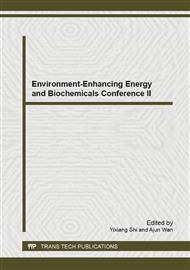[1]
L.E. de-Bashan, M. Moreno, J.P. Hernandez, Y. Bashan, Removal of ammonium and phosphorous ions from synthetic wastewater by the microalgae Chlorella vulgaris coimmbilized in alginate beads with the microalgae growth-promoting bacterium Azospirillum brasilense, Water Res. 36(2002).
DOI: 10.1016/s0043-1354(01)00522-x
Google Scholar
[2]
L.E. de-Bashan, A. Trejo, V.A.R. Huss, J.P. Hernandez, Y. Bashan, Chlorella sorokiniana UTEX 2805, a heat and intense, sunlight-tolerant microalga with potential for removing ammonium from wastewater, Bioresour. Technol. 99(2008) 4980-4989.
DOI: 10.1016/j.biortech.2007.09.065
Google Scholar
[3]
C.P. Feng, N. Sugiura, S. Shimada, T. Maekawa, Development of a high performance electrochemical wastewater treatment system, J. Hazard. Mater. B103(2003) 65-78.
DOI: 10.1016/s0304-3894(03)00222-x
Google Scholar
[4]
L.E. González, R.O. Cañizares, S. Baena, Efficiency of ammonia and phosphorus removal from a Colombian agroindustrial wastewater by the microalgae Chlorella vulgaris and Scenedesmus dimorphus, Bioresour. Technol, 60(1997) 259-262.
DOI: 10.1016/s0960-8524(97)00029-1
Google Scholar
[5]
J. Kim, B.P. Lingaraju, R. Rheaume, J.Y. Lee, K.F. Siddiqui, Removal of ammonia from wastewater effluent by Chlorella vulgaris, TsingHua Science and Technol. 15(2010) 391-396.
DOI: 10.1016/s1007-0214(10)70078-x
Google Scholar
[6]
M.S. Kumar, Z.H. Miao, S.K. Wyatt, Influence of nutrient loads, feeding frequency and inoculum source on growth of Chlorella vulgaris in digested piggery effluent culture medium, Boresour. Technol. 101(2010) 6012-6018.
DOI: 10.1016/j.biortech.2010.02.080
Google Scholar
[7]
N.F.Y. Tam, Y.S. Wong, Effect of ammonia concentrations on growth of Chlorella vulgaris and nitrogen removal from media, Boresour. Technol. 57(1996) 45-50.
DOI: 10.1016/0960-8524(96)00045-4
Google Scholar
[8]
L. Travieso, F. Benítez, E. Sánchez, R. Borja, A. Martín, M.F. Colmenarejo, Batch mixed culture of Chlorella vurlgaris using settled and diluted piggery waste, Ecol. Eng. 28(2006)158-165.
DOI: 10.1016/j.ecoleng.2006.06.001
Google Scholar
[9]
X. Li, H.Y. Hu, K. Gan, Y.X. Sun, Effects of different nitrogen and phosphorous concentrations on the growth, nitrogen uptake, and lipid accumulation of a freshwater microalga Scenedesmus sp, Bioresour. Technol. 101(2010) 5494-5500.
DOI: 10.1016/j.biortech.2010.02.016
Google Scholar
[10]
G.H. Chen, Electrochemical technologies in wastewater treatment, Sep. Purif. Technol. 38 (2004) 11-41.
Google Scholar
[11]
J.H. Fan, L.M. Ma, The pretreatment by the Fe-Cu process for enhancing biological degradability of the mixed wastewater, J. Hazard. Mater. 164(2009) 1392-1397.
DOI: 10.1016/j.jhazmat.2008.09.115
Google Scholar
[12]
C.J. Israilides, A.G. Vlyssides, V.N. Mourafeti, G. Karvouni, Olive oil wastewater treatment with the use of an electrolysis system, Bioresour. Technol. 61(1997) 163-170.
DOI: 10.1016/s0960-8524(97)00023-0
Google Scholar
[13]
M. Kobya, E. Senturk, M. Bayramoglu, Treatment of poultry slaughterhouse wastewaters by electrocogulation, J. Hazard. Mater. B133(2006) 172-176.
DOI: 10.1016/j.jhazmat.2005.10.007
Google Scholar
[14]
J. Mo, J.E. Hwang, J. Jegal, J. Kim, Pretreatment of a dyeing wastewater using chemical coagulants, Dyes and Pigments. 72(2007) 240-245.
DOI: 10.1016/j.dyepig.2005.08.022
Google Scholar
[15]
M. Panizza, G. Cerisola, Olive mill wastewater treatment by anodic oxidation with parallel plate electrodes, Water Res. 40(2006) 1179-1184.
DOI: 10.1016/j.watres.2006.01.020
Google Scholar
[16]
G.B. Raju, M.T. Karuppiah, S.S. Latha, D.L. Priya, S. Parvathy, S. Prabhakar, Electrochemical pretreatment of textile effluents and effect of electrode materials on the removal of organics, Desalination, 249(2009) 167-174.
DOI: 10.1016/j.desal.2008.08.012
Google Scholar
[17]
M. Panizza, G. Cerisola, Applicability of electrochemical methods to carwash wastewaters for reuse, Part 2: Electrocoagulation and anodic oxidation integrated process, J. Electroanal. Chem. 638(2010) 236-240.
DOI: 10.1016/j.jelechem.2009.11.003
Google Scholar
[18]
M.R.G. Santos, M.O.F. Goulart, J. Tonholo, C.L.P.S. Zanta, The application of electrochemical technology to the remediation of oily wastewater, Chemosphere. 64(2006) 393-399.
DOI: 10.1016/j.chemosphere.2005.12.036
Google Scholar
[19]
C. Comninellis, Electrocatalysis in the electrochemical conversion/combustion of organic pollutants for waste water treatment, Electrochimica Acta. 39(1994) 1857-1862.
DOI: 10.1016/0013-4686(94)85175-1
Google Scholar
[20]
P. Cañizares, A. Beteta, C. Sáez, L. Rodríguez, M.A. Rodrigo, Use of electrochemical technology to increase the quality of the effluents of bio-oxidation processes. A case studied, Chemosphere. 72(2008) 1080-1085.
DOI: 10.1016/j.chemosphere.2008.04.004
Google Scholar
[21]
N.A. Salles, F. Fourcade, F. Geneste, D. Floner, A. Amrane, Relevance of an electrochemical process prior to a biological treatment for the removal of an organophosphorous pesticide, phosmet, J. Hazard. Mater. 181(2010) 617-623.
DOI: 10.1016/j.jhazmat.2010.05.057
Google Scholar
[22]
S.H. Lin, C.L. Wu, Electrochemical removal of nitrite and ammonia for aquaculture, Water Res. 30(1996) 715-721.
DOI: 10.1016/0043-1354(95)00208-1
Google Scholar
[23]
A. Kapałka, A. Cally, S. Neodo, C. Comninellis, M. Wächter, K.M. Udert, Electrochemical behavior of ammonia at Ni/Ni(OH)2 electrode. Electrochem. Commun. 12(2010) 18-21.
DOI: 10.1016/j.elecom.2009.10.026
Google Scholar
[24]
L. Li, Y. Liu, Ammonia removal in electrochemical oxidation: Mechanism and pseudo-kinetics, J. Hazard, Mater. 161(2009) 1010-1016.
DOI: 10.1016/j.jhazmat.2008.04.047
Google Scholar
[25]
J.F.E. Gootzen, A.H. Wonders, W. Visscher, R.A. Van Santen, J.A.R. Van Veen, A DEWS and cyclic voltammetry study of NH3 oxidation on platinized platinum, Electrochim. Acta. 43(1998) 1851-1861.
DOI: 10.1016/s0013-4686(97)00285-5
Google Scholar
[26]
N. Bektaş, H. Akbulut, H. Inan, A. Dimoglo, Removal of phosphate from aqueous solution by electro-coagulation, J. Hazard. Mater. 106B(2004) 101-105.
Google Scholar
[27]
M.E. Martínez, S. Sánchez, J.M. Jiménez, F.E. Yousfi, L. Muñoz, Nitrogen and phosphorous removal from urban wastewater by the microalga Scenedesmus obliquus, Boresour. Technol. 73(2000) 263-272.
DOI: 10.1016/s0960-8524(99)00121-2
Google Scholar


